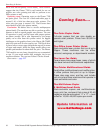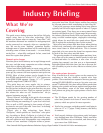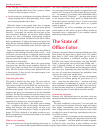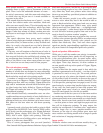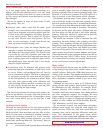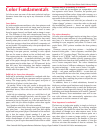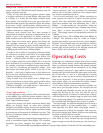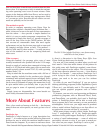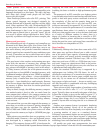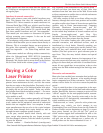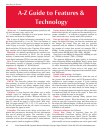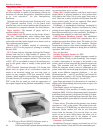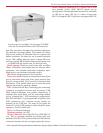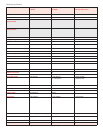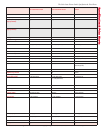
64
Entire Contents © 2006 Prog
ressiv
e Business Pub
lications
.
Copying of Pages Prohibited.To Order: 800 247 2185 or www.betterbuys.com
Some printers don’t employ the original Adobe
PostScript but instead use a PostScript-compatible print
l
anguage developed by a third party. This isn’t a big neg-
ative these days, though some people still feel more
secure with the original.
Most PostScript printers also offer PCL printing. This
printer control language was designed originally by
Hewlett-Packard and is generally used for everyday office
work. Other machines offer only Windows-based GDI
printing, which has a more limited set of capabilities. Its
main disadvantage is that it can tie up your computer
until the page is printed; that is, you can’t “spool” the job
to a server or printer and get right back to work. That is
especially a problem with longer and more complex jobs.
Memory and processors
The relationship and role of memory and controllers are
discussed in the Better Buys
Office Laser Printer Guide. We
are not going to dwell much on them here, save to say
that more memory and powerful controllers enhance a
printer’s speed and ar
e essential f
or more ambitious types
of work. (Controllers are the so-called front end of print-
ers and they process incoming data sent from connected
PCs.)
The g
ood news is that vendors are becoming more gen-
erous with the amount of memory they package into
their color laser printers as standard. Only a couple years
ago, printers with 64MB of memory were in the minori-
ty. Today, however, all but a few of the printers covered in
this guide have at least 64MB of standard memory, with
a substantial n
umber offering a
t least 128MB as standard.
“Memor
y-starved” color printers — those with 64MB of
memory (only a handful now have less) included in the
basic deal — ha
ve dwindled to a small minority. Because
color files are bigger than black-and-white files, the need
for memory is greater than that for similar speed black-
and-white printers.
Keep in mind, though, that differing memory compres-
sion methods make it hard to infer too much from the
e
xact amount tha
t’s offered. Also, memory matters a lot
more for PostScript printing than for PCL printing from
standar
d of
fice a
pplica
tions
.
F
or GDI printing
,
memory
is not an issue.
Rest assured that you can often upgrade the memory to
mor
e than y
ou would ever dream of getting, though this
does ad
d some cost into the equation. For example,
OKI’s C9600 and C9800 color printer series will allow
you to boost the memory as high as 1,024MB (one giga-
byte).
Most printers use controllers that are proprietary to the
indi
vidual model. However, a few use dedicated proces-
sors developed by a company called Electronics for
Imaging
.
T
his compan
y
,
kno
wn as EFI,
is best known for
supplying the front ends to connected color copiers
(enabling the latter to double as high-performance print-
ers).
The presence of an EFI controller on a desktop printer
is a good indication that the machine has sufficient horse-
power to deal with pretty serious workloads in terms of
the complexity of files and the quantity being sent in
close succession. That isn’t to say that non-EFI con-
trollers are necessarily less powerful. It’s just that it’s hard
for a buyer to assess the performance of a controller from
specifications alone unless it is made by a recognized
third party that supplies more or less the same front ends
to a variety of different vendors. In short, there is a
degree of comfort in knowing that a controller is EFI-
supplied. However, printer vendors have not been asleep
during the past few years, and several have controllers of
their own that are comparable to EFI’s.
Paper handling
Traditionally, desktop color lasers have come with a 250-
sheet paper tray and have allowed you to add a second
one as an option. Paper capacity is becoming more gen-
erous, however, and several recently introduced models
offer additional standard 250-sheet trays, 500- or 550-
sheet tr
ays, and e
ven a 2,000- or a 2,500-sheet tray in sev-
eral cases. Larger tray capacities are likely to be particu-
larly important if you also plan to use your color laser as
a mainstr
eam black-and-w
hite printer.
Often, the standard 250-sheet tray is supported by a
multipurpose tray holding 100–150 sheets. As well as
of
fering the con
venience of a second active paper source,
this tray can often take heavier paper weights than the
main tray. By no means are all machines suitable for
hea
vy pa
per or light card stock — be sure to satisfy your-
self that the printer is comfortable with any challenging
materials you want to feed it.
There are now a fairly large number of machines on the
market that are able to take 11" x 17" (or ledger-size)
paper. Typically, these can actually take paper a little larg-
er than tha
t in or
der to give you the ability to print 11" x
17" images with full bleed (the image going off the edge).
Among other things
,
this is v
er
y helpful f
or pr
oducing
proofs of layouts that are being sent out to a commercial
printer.
Another no
w-common f
eature is automatic duplexing
(double-sided printing). Nearly all of the printers we
cover now offer this, more frequently as an option, but in
a growing number of cases as a standard feature.
Previously, even manual duplex was not typically recom-
mended on desktop color lasers because of paper-jam-
ming issues
. Shorter paper paths and better paper-feeding
technology have overcome much of this problem.
All models can print onto tr
anspar
encies
,
b
ut most
Better Buys for Business



